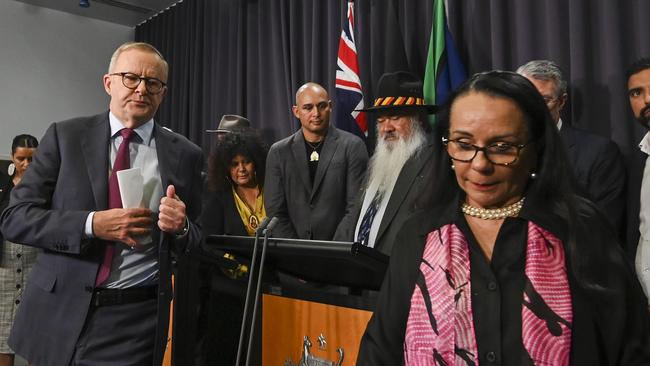
As support for the referendum began tanking in May and continued its devastating slide ahead of the Garma Festival, some Yes campaigners came to believe Anthony Albanese had “drunk his own Kool-Aid”.
In the months before the annual four-day celebration of Yolngu life in remote northeast Arnhem Land, concerned Yes campaigners made high-level representations to the government about better explaining how the voice would work and presenting more practical examples.
After claiming a history-making Aston by-election victory on April 1, and with his political standing dominant 12 months after returning Labor to power, Albanese offered no flexibility and no change in course.
Seeking to counter the ruthless weaponisation of the information vacuum by No campaigners, Yes supporters desperate for more details on the voice would win no concessions from the Prime Minister.
Yes and ALP sources say the idea was rejected due to fears that voters would get “caught in the weeds” like they did ahead of the doomed 1999 Republic referendum. Any consideration of delaying the referendum was rejected by senior government figures and prominent Indigenous leaders.
As the sell became tougher for Yes campaigners, cabinet ministers found themselves struggling to explain how the voice would work and how Indigenous Australians would benefit. Some ministers, who registered emphatic No votes in their electorates on Saturday night, felt Albanese should have considered a second-term referendum allowing ample time for consultation on the design and functions of a voice advisory body.
Adding to the concerns of Albanese’s colleagues were 12 rate hikes in just over a year, record energy and grocery bills, soaring petrol prices and insurance premiums, massive rent hikes and a housing crisis.
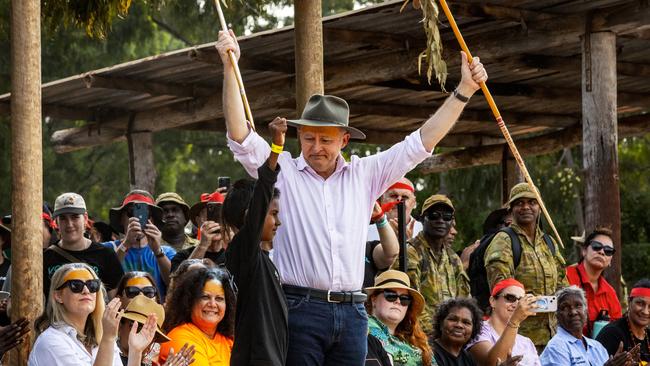
A Yes23 source said focus groups and polling consistently showed cost-of-living issues were “number 1, 2, 3, 4-to-10”. The No, Liberal and ALP pollsters were seeing the same trends. The voice never got a look-in.
“Yes was fighting against this all year. The campaign threw the kitchen sink at moving the vote and it just didn’t happen,” the source said.
“Even though there was an odd wave of interest in the voice it just didn’t grab people’s attention. We were still finding in focus groups in the weeks before October 14 that there was a low information environment out there. People had limited awareness. There was a cursory understanding something was happening. The opposition also did a very good job of making this Albo’s proposal.”
A core group of 10 Yes23 campaign officials, led by former Victorian Liberal Party state director and Yes23 chief operating officer Simon Frost and campaign director Dean Parkin, co-ordinated the ground game from bases across the country.
Yes23 HQ, armed with an unprecedented war chest to fund mass advertising campaigns, pumped resources into key states, led the political strategy at arm’s length from the ALP, and co-ordinated logistics for Indigenous leaders, politicians, high-profile sporting and corporate figures.
‘It didn’t help the government that they made the voice a partisan issue. Even as late as August, the PM could have chosen to pull the pin on this model.’
Long-time Noel Pearson ally and Yes23 co-chair Danny Gilbert – co-founder of Gilbert + Tobin, co-chair of Cape York Partnership Group and Business Council of Australia director – was the money man. With the support of other business leaders on the Yes23 board, Gilbert amassed a mammoth corporate and philanthropic fighting fund expected to nudge $50m.
The fundraising drive attracted millions of dollars in direct and logistic support from the big banks, Qantas, billionaire Anthony Pratt, Wesfarmers, BHP, Rio Tinto and others. The Yes cash pile dwarfed the largely grassroots donations received by the No campaign.
The Australian understands Gilbert’s role as chief fundraiser afforded him special sway over Yes advocates and that he was fiercely protective of the agreed constitutional amendment that gave the voice its broad scope to talk to government and parliament.
A Yes23 strategist said all members of the Yes23 board, which met monthly and more frequently as referendum day approached, were active participants.
Former Kevin Rudd adviser and businessman Lachlan Harris provided high-level strategic communications advice, former Liberal Party federal director Tony Nutt and pollster Mark Textor gave political advice and Indigenous board members helped bring together key First Nations leaders and supporters.
“Our field operation was enormous,” the Yes23 strategist said. “We had co-ordinators in each state and they led the massive grassroots campaign. We pushed all the way to the finish line because entering the final week there were 25 per cent of Australians who hadn’t made up their minds. In the final days, there was still around 20 per cent still uncommitted.”
Pearson – a powerful thinker, a reformer as well as an unpredictable and sometimes hostile character – was charming and engaging as he criss-crossed the country to sell the voice. However, behind the scenes Pearson was understood to be pessimistic about the referendum’s chances and issued signature eviscerations of those he deemed to be enemies of the campaign. One source said that early on when some Indigenous leaders on Albanese’s referendum working group believed the No campaign would be nothing more than cranks, Pearson always knew it would be hard to win the referendum.
While the No side was a smaller, uniform outfit, the Yes camp was made up of multiple bodies and third-party groups that increasingly disagreed with campaign tactics as public support plunged.
The Australian understands that union leaders and ALP strategists in some states became increasingly frustrated by Yes23 campaign headquarters, with some reporting they were told what to do and that their advice fell on deaf ears.
With the ALP not running its own advertising campaign, all monies raised by the party machine was funnelled into Yes23 and Uluru Dialogue, led by professor Megan Davis and Indigenous leader Pat Anderson.
Key figures from the separate campaigns publicly expressed unity and co-operation, but as support waned they privately critiqued each other’s tactics and the effectiveness of their advertising spends, including the Uluru Dialogue’s high-profile John Farnham-backed You’re the Voice campaign that some felt “targeted inner-city voters”.
Senior Yes23 officials held high-level discussions around six-months-ago about executing a negative advertising blitz to avoid losing traction early to the No side, which was shifting ground through “fear campaigns” about financial compensation, land rights and treaty.
While a decision was made to stay positive and resist highlighting consequences of a No vote for Aboriginal and Torres Strait Islander people, an alternative advertising campaign was devised in case popular support for Yes23 continued tanking. As tracking polling revealed dramatic slides in support, Yes campaigners held rolling discussions about a major shift in messaging and bringing forward the negative advertising blitz.
Internal angst about following the No side down a negative path held back execution of the alternative push for soft and undecided voters. Those in favour argued Yes23 must fight fire with fire and deploy more ruthless tactics, mirroring strategies used by political parties during election campaigns.
Four weeks out from referendum day and facing defeat, Yes23 finally approved the negative campaign strategy. For some of the more hardened political campaigners, the decision came too late.
“There is an argument that the negative campaign should have rolled out earlier. Regardless, the reality was that millions of people weren’t listening. The vibe for voters was about petrol and power prices,” a Yes campaigner said.
“It’s about the salience, the relevance, tuning in. Indigenous disadvantage just doesn’t cut through. Some people will try to pin it on ill will, but that’s just not the case.”
Ghosts of leaders past
When Albanese strode to the winner’s stage at the Canterbury-Hurlstone Park RSL Club in Sydney on May 21, 2022, a core group of trusted friends, colleagues and advisers knew the incoming Labor government would commit to a voice referendum within months.
The clique understood the significance of the PM-elect launching his election victory speech with a recommitment to the voice and implementing the Uluru Statement From the Heart in full. Within 17-months, Australians would head back to the polls for the nation’s first referendum since the failed 1999 republic vote, when Australians also voted down a proposal to add a preamble to the Constitution recognising Indigenous Australians as the first peoples.
Back then, the recognition question got a Yes vote of 39.34 per cent and it was defeated in every state and territory, an almost identical result to Saturday’s referendum For Albanese’s chief-of-staff Tim Gartrell, delivering meaningful constitutional recognition for Indigenous Australians was a personal mission. Gartrell, who ran Albanese’s inaugural Grayndler campaign in 1996, masterminded Rudd’s 2007 election win and led Yes to an emphatic marriage equality victory in 2017, had initially quit politics to dedicate himself to Indigenous recognition.
In 2010, he was appointed chief executive of Generation One, an Indigenous employment advocacy organisation. In 2012, he became director of Reconciliation Australia’s Recognise campaign, working alongside future Yes23 board member and AFL executive Tanya Hosch. Hosch delivered an emotional speech at the Yes23 campaign launch in Adelaide days after having her leg amputated due to diabetes, a disease that disproportionately affects Indigenous people.
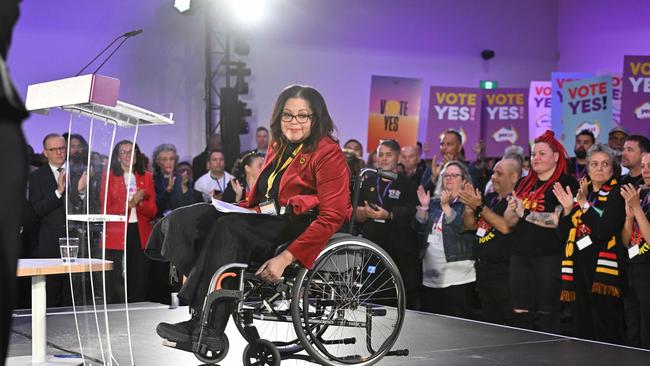
With Gartrell leading his office, Labor flying high in the polls and the Coalition in tatters after the teals uprising, Albanese felt bulletproof despite securing a historically low 32.6 per cent of the primary vote at the 2022 election.
Albanese’s confidence, driven by sky-high personal popularity, lifted to new heights on April Fool’s Day when Labor became the first incumbent government to steal an opposition electorate since 1920. The April 1 Aston by-election defeat left the Liberals with two federal seats in metropolitan Melbourne and plunged Peter Dutton’s leadership into crisis.
Two days after the by-election, Albanese marked the death of Gumatj clan leader Yunupingu, the land rights giant who shunned bureaucrats and dealt directly with prime ministers.
“At Garma last year, after I announced the details of the referendum, he asked me, ‘Are you serious this time?’ I replied: ‘Yes, we’re going to go for it.’ When I spoke with him just over a week ago, I told him I was confident we would get there,” Albanese wrote.
Immersed in self-belief, Albanese held a burning ambition to emulate Labor heroes Gough Whitlam, Bob Hawke and Paul Keating. He regularly spoke of Wik, Mabo, native title, the Redfern Speech, Vincent Lingiari and the 1967 referendum ensuring Indigenous Australians would be counted as part of the population and that the commonwealth would be able to make special laws for them. His confidence was unflappable. He was a history-maker who could become the first prime minister to win a referendum without bipartisan support.
All or nothing
With a majority of Australians still backing an Indigenous voice in April, the Coalition’s electoral prospects hitting rock bottom and his personal ratings in poor shape, Dutton made his Hail Mary, all-or-nothing play.
On April 5, four days after losing the Aston by-election, the Liberal leader joined the Nationals in formally opposing Albanese’s voice referendum and pledging allegiance to the No campaign.
In the process, Dutton lost his opposition Indigenous Australians and legal affairs spokesman Julian Leeser, who quit the frontbench to campaign for the voice. Leeser, considered one of the Coalition’s sharpest minds, was a co-architect of the first constitutional voice proposal conceived in 2012 alongside Pearson, then-Australian Catholic University vice-chancellor Greg Craven and conservative intellectual Damien Freeman.
Leeser – who is expected to return to the Coalition frontbench following the referendum – was replaced by rookie Northern Territory Country Liberal Party senator Jacinta Nampijinpa Price as Indigenous Australians spokesperson.
The elevation of the lead No campaigner, a darling of the conservative elite and who previously worked with right-wing activist group Advance and the Centre for Independent Studies, was a game-changer.
Some in the No camp say the former Alice Springs deputy mayor and daughter of former Northern Territory MP Bess Price was written-off by Yes supporters and the Albanese government, who underestimated her appeal to mainstream conservative Australians. Senior Labor figures say this was never true. There was an immediate appreciation that Price’s arrival in the referendum debate was problematic on several fronts, not least because it demonstrated to Australians that not all Indigenous people wanted the voice.
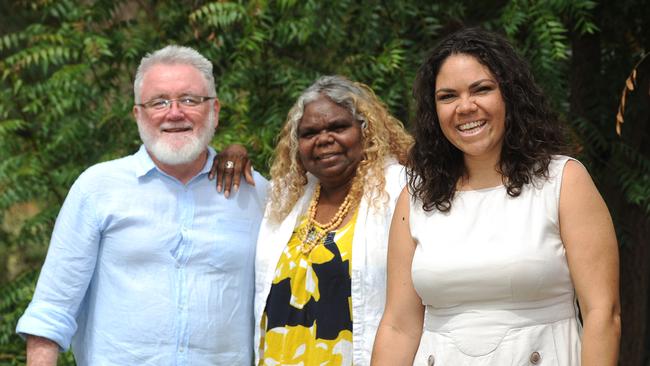
Despite angst among moderate Liberal MPs who survived the teals bloodbath, only Leeser, rogue Tasmanian Liberal MP Bridget Archer and NSW senator Andrew Bragg broke ranks to campaign for Yes. Then the Coalition made highly effective attacks on the Western Australian government’s unpopular new Aboriginal cultural heritage laws, which the Pastoralists and Graziers Association claimed would erode property rights, disrupt operations and force them to incur heavy heritage survey costs. The laws were portrayed as a hint of more to come if the voice succeeded and voters began to worry they would be prevented them from doing work on their own suburban blocks.
Holding all the cards
About three months after the May election, Albanese, Indigenous Australians Minister Linda Burney and Attorney-General Mark Dreyfus landed on the final make-up of their First Nations working group and constitutional expert group.
Appointments included veteran Indigenous activists, emerging leaders and prominent constitutional law experts who would guide the final constitutional amendment and design of the voice advisory body.
While Albanese presented the working group process as the first step towards the referendum, the path from consultation to finalisation was swift. The proposal, which was viewed as pre-ordained, was for an advisory body for both the parliament and executive government.
In March, The Australian revealed Dreyfus and Solicitor-General Stephen Donoghue had put forward a suggested change to the wording of the proposed amendment to working group members, which some believed was an attempt to water down the powers of the voice.
The change, which would have provided greater scrutiny around advice to executive government, was unanimously rejected by the working group and immediately shelved by the government. The Australian has been told this was not Dreyfus’ first attempt to alter the words of the proposed amendment.
‘One working group member anonymously described Greg Craven as a “crybaby” after not getting his way.’
The referendum working group had been due to settle the wording of the proposed amendment with Dreyfus, Labor senator Pat Dodson and Burney in Adelaide on March 16, but talks got bogged down. It was decided that a delegation of six Indigenous leaders from the group would go to Canberra to continue negotiations with the Prime Minister the following week, when he was due home from AUKUS meetings.
What followed was a 2½-hour meeting in Parliament House on March 21 described to The Australian at the time as “a very heavy meeting” and “emotional” with “many tears”. Ultimately, Albanese broke the stalemate with a suggestion that was accepted by the delegation: Megan Davis, Pat Anderson, Marcia Langton, Tony McAvoy SC, Ken Wyatt and Thomas Mayo.
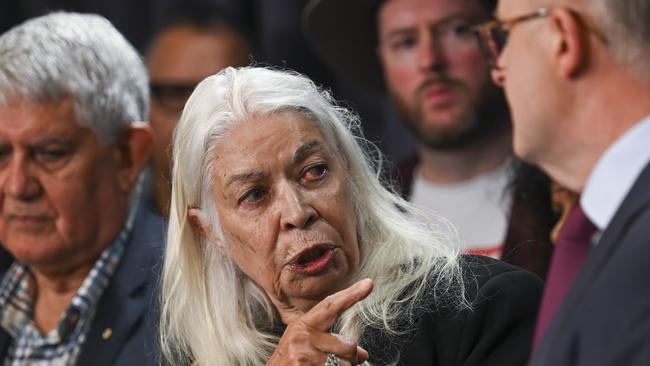
Previously, the proposal was that the parliament would make laws about the voice’s composition, functions, powers and procedures. With this change, however, the parliament’s authority was expanded beyond these four things to “matters relating to the Aboriginal and Torres Strait Islander voice, including its composition, functions, powers and procedures”.
Former High Court chief justice Robert French had advised on the initial wording announced at Garma last year, but The Australian has been told he also approved of the new wording because it was left open to the parliament to make laws as to the legal effect of the voice’s advice.
Interestingly, this change came without input from the government’s own constitutional expert group on the voice. The expert group had not been asked for any more advice after February 19 when group member Greg Craven upset Indigenous leaders by claiming there was an “all or nothing” faction in the Yes campaign that would rather see the Indigenous voice to parliament fail if it did not reflect their vision. One working group member anonymously described Craven as a “crybaby” after not getting his way when he pushed hard to remove the voice’s ability to advise executive government. There were even rumblings that he should be dropped from the expert group.
Craven, a voice supporter, said at the time: “I would much rather be dropped than not tell the truth and see the referendum fail. And we will see who is crying at the end.”
Central to Craven’s fears was that the voice would be able to advise on defence, national security and foreign affairs matters.
Constitutional law experts Anne Twomey and George Williams also challenged Albanese’s public claims that parliament would control what matters the voice could consider. Following intervention by the legal experts, the Prime Minister dropped his argument that the third clause of the proposed constitutional amendment delivered “primacy of the parliament for what the voice will consider”.
Price x-factor
The origins of the Fair Australia No campaign trace back to August 2022, days after Albanese’s Garma Festival speech in which he unveiled the first incarnation of the proposed constitutional amendment for the voice.
Backed by a $1m donation in November, right-wing activist group Advance began assembling its core personnel spread across the country. The No team would grow to about 30 key campaigners by referendum day.
As Advance progressed its fledgling No outfit, a group led by Price, Warren Mundine, former deputy prime minister John Anderson and former Labor minister Gary Johns formed the Recognise a Better Way campaign. Before entering politics, Price had worked as a spokeswoman for Advance and was Indigenous affairs program head at the CIS.
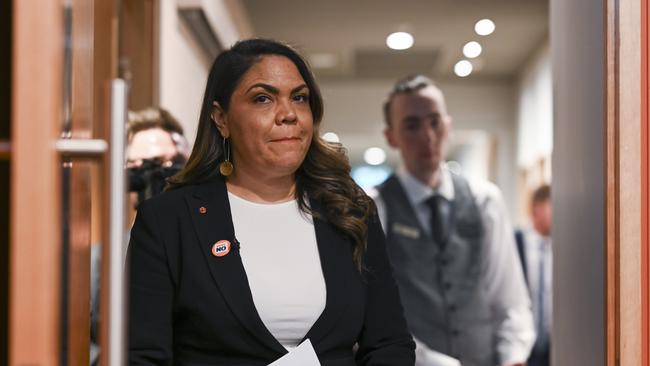
By February, The Australian revealed that Price had jumped ship to lead the Fair Australia campaign. Amid concerns about two competing No campaigns, Mundine, Johns and Anderson would also get behind Advance’s fundraising, organisational and campaigning arms, which were supported by the right-wing Institute of Public Affairs think-tank.
Fair Australia’s March referendum electoral strategy, informed by research and polling conducted in January, revealed that Yes needed 8.7 million votes across a majority of states versus 3.5 million votes from three states for No. At that time, No campaigners were focused on spoiling the majority of states required by Yes23.
The blueprint obtained by The Australian showed that cost-of-living pressures were dominating the minds of voters.
“That strategy never changed. Once it was set in stone the team was completely committed to it under the leadership of Warren and Jacinta. We decided that consistency was the best way forward. From those early polls, the economy and cost-of-living dominated,” a senior No campaign source said. “We saw a 5 to 7 per cent vote shift very early just on the constitutional change. That was back in January.”
In addition to older voters being hesitant to support a major alteration to the nation’s founding document, the No campaign seized on concerns around Makarrata and treaty, financial compensation and land rights. The Coalition’s focus on legal challenges in the High Court was a second-order issue for many voters.
No’s electoral strategy focused on harnessing and harvesting data based on a principle that “modelling will find the best 60 per cent of the vote in target states using census, commercial data and analytics”.
“This will drive advertising and voter contact in field. (The) voter target is the top 65 per cent of battleground states totalling 4,550,000 voters. (There are) 7000 booths nationwide that will require 70,000 volunteer hours to cover election day (and) 1300 pre-poll stations that will require 82,000 volunteer hours to cover pre-poll,” the document said.
On October 14, the No campaign backed by Liberal and Nationals members had 25,000 volunteers manning booths compared with Yes23’s 70,000-strong volunteer army.
In support of its fledgling four-stage advertising campaign, focused heavily on Price, Fair Australia’s plan was to make more than 22 million contacts via phone calls, letterbox drops and direct mail. The first advertising campaign, launched across March and April, was anchored by a five-minute Price documentary to establish her credibility and name.
“It was huge. People came to understand who Jacinta was and have empathy and sympathy for her story. But she wasn’t alone. Warren was a big factor and there was Indigenous person after person who said the voice doesn’t speak for me,” a No insider said.
A Fair Australia source said their fortunes shifted rapidly following the launch of the ad campaign, the Liberals’ coming out in support of No and attacks on prominent Yes23 campaigners including militant unionist Thomas Mayo.
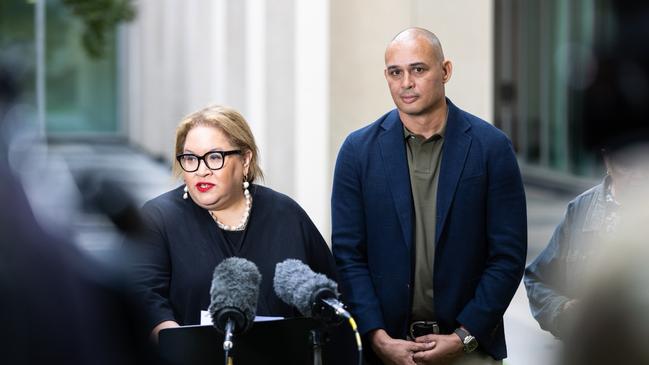
“It didn’t help the government that they made the voice a partisan issue. Even as late as August, the PM could have chosen to pull the pin on this model. It was wrong to suggest that No campaigners weren’t supporters of Indigenous recognition.
“We were accused of lies and mistruths when we pointed out divisive comments made by people like Thomas Mayo, Megan Davis, Marcia Langton, Noel Pearson and Albanese. Those claims were just not credible.”
Price’s cut-through, the Coalition support and scrutiny of Yes campaigners turned the referendum campaign. Yes23 was also outmanoeuvred by No’s ability to reach bigger audiences via digital platforms including TikTok.
“We ended up with about 30 in the core team across digital, communications, field co-ordination, admin, finance, fundraising and strategy,” the source said. “It was a small team. While we stayed focused on our mission, every time the Yes side changed their messaging, they changed the clock and the effectiveness of their reach.”
No campaign confidence levels were so high in the final weeks that Dutton was never required to join the hustings and Price took three days’ leave to celebrate the 50th birthday of her husband Colin Lillie.
Yes campaigners, infuriated by Price’s inflammatory comments including that colonisation had only a positive impact on Indigenous Australians, failed to land a blow on the No campaigner. Asked about Price’s effectiveness, Yes strategists often found it difficult to acknowledge the damage she was inflicting on their cause.
The big spend
Between the AEC, Yes23, Uluru Dialogue, Fair Australia, Clive Palmer, corporate Australia, Liberals, Nationals, ALP, unions, GetUp and others, the final spend on running the referendum and advocating for a Yes or No vote is expected to come close to $750m.
A senior No campaigner said “the blunt instrument of market share no longer wielded the power it once did”.
“Given recent trends on voter turnout and engagement, campaigns can no longer rely on compulsory voting. It’s about providing motivation for people to vote along with persuasion.
“We’ve seen the results of huge spends that don’t deliver. Clive Palmer and now Yes23 and Uluru Dialogue. Money matters but it’s not as meaningful as it once was because the traditional news cycle model has been up-ended.”
The clash between Yes and No over grassroots versus corporate donations dominated public debate. Yes23 sought to present itself as a grassroots movement but struggled to reconcile the massive warchest backed by corporate behemoths. In a cost-of-living crisis, there is limited tolerance for the big banks and companies as they pursue social causes while raking in record profits.
The No campaign said “everything was stacked against us” as they lined-up against the ALP campaign machine, third-party activist groups, cashed-up philanthropic donors and big business.
Getting jittery
Labor MPs were increasingly anxious about Albanese’s “hubris” and the ability of Linda Burney to sell the Yes vote. Burney was relentlessly pursued by the Coalition in Question Time.
In an early blow for Yes23, WA Labor Senator Pat Dodson – the Father of Reconciliation and Albanese’s special envoy for implementation of the Uluru Statement From the Heart – was forced off the campaign trail until the final weeks as he battled incurable Hodgkin’s lymphoma.
A Labor MP said the government had tried and failed to “walk and chew gum at the same time”.
“People are grappling with a cost-of-living crisis and we’re out there talking about the voice every day. It’s an important issue but there was a sense we were distracted from our day job,” the MP said.

The Australian understands senior ministers who had developed economic, national security and social policies and strategies were instructed to put them on ice until after the referendum.
When Albanese and son Nathan cast their votes sevendays before referendum day, the mood in Labor ranks sank. It was an unprecedented move for a leader to vote a week early but Yes campaigners, concerned they were losing momentum, felt the Prime Minister could swing undecided voters.
There was a sense of desperation as Albanese led a frantic final week push, overshadowed by the Israel-Hamas war and fallout both abroad and domestically. Albanese’s focus on the voice was attacked by the Coalition following ugly scenes at pro-Palestine rallies in Sydney. Albanese, who blitzed the battleground states of South Australia and Tasmania, wept in Uluru as he met with traditional elders at the birthplace of the Uluru Statement from the Heart.
As the No campaign retreated from public campaigning, Yes23 threw what it had left in the tank to swing millions of undecided voters in the final days of the campaign. Despite a late shift back to Yes, Yes23 campaigners entered the final week knowing their cause was likely lost.
PM enters danger zone
Labor insiders believe Albanese alone will wear the fallout of the voice referendum given his refusal to pursue bipartisan support and stubborn inflexibility on the model. ALP strategists have spent recent weeks preparing a rapid transition back to core issues confronting households and businesses, including action on the cost-of-living crisis, housing and health.
Following a bruising week of question time when parliament returns on Monday, Albanese will head to Washington to attend a White House state dinner. Albanese will next month travel to Beijing, attend the Pacific Islands Forum in Cook Islands and the APEC summit in San Francisco.
The busy travel schedule and pre-Christmas sitting weeks complicate Albanese’s ambition to reclaim clean air heading into the new year.
Albanese, who views himself as the only credible Labor leadership option, never contemplated a David Cameron Brexit-style exit.
Nineteen months out from the 2025 election – and with Queensland Labor on track for defeat next year – Albanese is under pressure to brush-off the referendum defeat, neutralise brawls with business on IR changes, avoid recession, lift productivity, manage natural disasters and meet Labor’s climate change targets.
The Coalition does not expect there will be baseball bats out for the 60-year-old. However, it considers this a heavy defeat that Australians may come to see as an indictment on Albanese’s judgment and competence.

More Coverage
Add your comment to this story
To join the conversation, please log in. Don't have an account? Register
Join the conversation, you are commenting as Logout